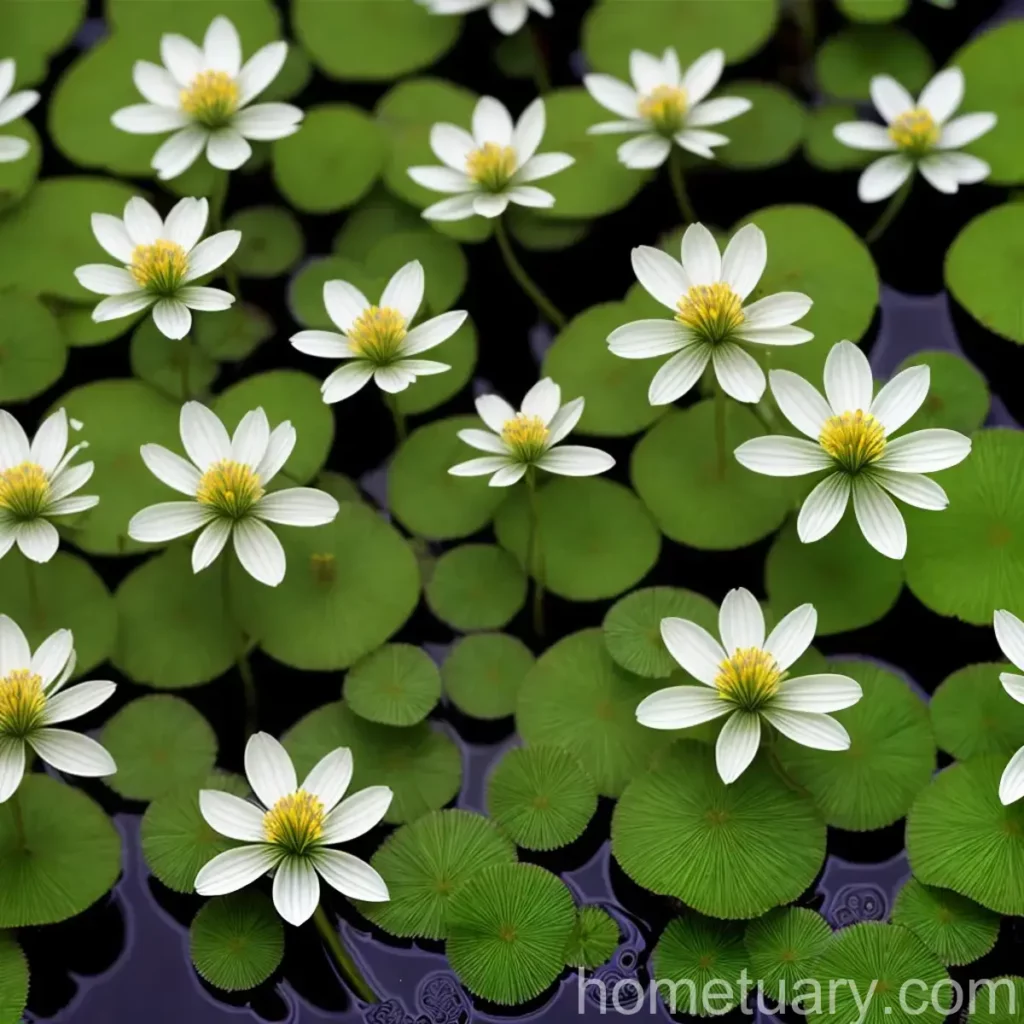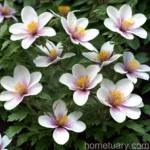European Water Clover (Marsilea quadrifolia): A Comprehensive Guide
Marsilea quadrifolia, commonly known as European water clover, is a delightful aquatic plant native to Europe and Asia. As a plant scientist, I am excited to delve into the fascinating world of this unique plant species with you. In this comprehensive guide, we will explore the various aspects of European water clover, including its culture, uses, maintenance, and much more.
What is European Water Clover (Marsilea quadrifolia)?
European water clover, scientifically classified as Marsilea quadrifolia, belongs to the Marsileaceae family. This aquatic plant is characterized by its clover-like, four-leafed fronds, which give it a distinctive and charming appearance. Typically found in shallow waters, European water clover is known for its ability to thrive in various aquatic environments, making it a popular choice for water gardens, ponds, and aquariums.
The unique morphology and adaptability of European water clover make it a captivating addition to both natural and cultivated aquatic settings. With its fascinating biological characteristics and cultural significance, this plant offers a multitude of opportunities for exploration and appreciation.
Key Takeaways – European Water Clover (Marsilea quadrifolia)
Before we embark on an in-depth exploration of European water clover, let’s take a moment to highlight the key takeaways that will be covered in this comprehensive guide:
- Culture
- Uses
- Water
- Sunlight
- Fertilizer
- Soil
- Pruning
- Propagation
- Container Popularity
- Container Common Diseases
- Disease Diagnosis
- Common Pests
- Botanist’s Tips
- Fun Facts
- Links to External Resources
Now, let’s delve into the fascinating world of European water clover and unravel the intricacies of its care, maintenance, and unique characteristics.
Culture
Uses
European water clover, with its charming appearance and adaptable nature, serves various purposes in horticulture and environmental conservation. Some notable uses of Marsilea quadrifolia include:
- Aquatic Gardens: European water clover is a popular choice for enhancing the aesthetic appeal of aquatic gardens and ponds.
- Landscaping: Its unique foliage adds visual interest to landscapes, and it can be incorporated into wetland and water feature designs.
- Aquariums: European water clover is an excellent addition to freshwater aquariums, providing naturalistic elements and serving as a refuge for aquatic organisms.
- Ecosystem Support: In natural ecosystems, European water clover contributes to habitat diversity, supporting various aquatic organisms and promoting ecological balance.
The versatility of European water clover makes it an invaluable asset in both ornamental and ecological contexts, enriching aquatic environments and providing aesthetic pleasure to enthusiasts and conservationists alike.
Water
As an aquatic plant, European water clover has specific water requirements that are essential for its growth and vitality. Understanding these requirements is crucial for successfully cultivating and maintaining this species. The following factors are important considerations when it comes to providing the appropriate water conditions for European water clover:
- Water Quality: The water quality should be maintained at optimal levels, free from pollutants and excessive nutrient loads that could compromise the health of the plant.
- Temperature: European water clover thrives in moderate to warm water temperatures, typically in the range of 68-82°F (20-28°C).
- Depth: Depending on the cultivation environment, European water clover can be grown in shallow waters or submerged to a certain depth, allowing for flexibility in its placement within aquatic settings.
- Water Movement: Gentle water movement and aeration are beneficial for European water clover, ensuring adequate oxygenation and nutrient distribution around the plant.
By paying attention to these water-related factors, enthusiasts can create an ideal habitat for European water clover, promoting its lush growth and overall well-being.
Sunlight
Proper sunlight exposure is a critical factor for the health and development of European water clover. Understanding its sunlight requirements and ensuring appropriate light availability are fundamental aspects of its care and maintenance:
- Light Intensity: European water clover thrives in moderate to bright indirect light. When cultivated outdoors, it benefits from partial shade to prevent excessive sunlight exposure.
- Duration: Providing 8-10 hours of light per day is generally suitable for European water clover. In indoor settings, natural or artificial light sources can fulfill its sunlight needs effectively.
- Light Spectrum: The plant responds well to full-spectrum lighting, encompassing the essential wavelengths for photosynthesis and overall growth.
Balancing the sunlight exposure for European water clover is crucial, as it directly impacts its photosynthetic activity, leaf coloration, and overall vigor.
Fertilizer
In aquatic environments, the availability of nutrients can significantly influence the growth and vitality of European water clover. While natural nutrient cycles within water bodies may provide essential elements, supplemental fertilization can be beneficial for optimizing the plant’s health. Consider the following guidelines for fertilizing European water clover:
- Aquatic Fertilizers: Specialized aquatic fertilizers formulated for submerged and aquatic plants can be used to support the nutrient requirements of European water clover.
- Nutrient Balance: Balancing the nutrient levels in the water is crucial to prevent excessive accumulation and to support healthy growth without promoting algae proliferation.
- Frequency: Depending on the nutrient availability in the cultivation environment, periodic fertilization can be undertaken to ensure the sustained health and vigor of European water clover.
Adhering to appropriate fertilization practices is essential for maintaining the nutrient balance and promoting the robust growth of European water clover within aquatic settings.
Soil
European water clover’s unique adaptation to aquatic environments eliminates the traditional soil considerations associated with terrestrial plants. Instead, it thrives in aquatic substrates and waterlogged conditions, exhibiting adaptations that allow it to flourish in the absence of conventional soil. When growing European water clover, considerations related to the composition and maintenance of aquatic substrates are paramount:
- Substrate Composition: Utilizing specialized aquatic substrates or inert materials such as gravel, sand, or aquatic soil enables the cultivation of European water clover within aquatic environments. These substrates provide anchorage and support for the plant’s rhizomes and roots.
- Aeration: Incorporating porous substrates facilitates oxygenation of the root zone, ensuring that the plant’s below-ground structures receive adequate oxygen for metabolic processes.
- Water Retention: The substrate should possess sufficient water retention capacity to ensure consistent hydration of the plant, promoting optimal growth.
Understanding the dynamics of aquatic substrates and their role in European water clover cultivation is essential for creating a suitable and supportive environment for the plant.
Pruning
Proper maintenance, including regular pruning and upkeep, is integral to the health and aesthetics of European water clover. Implementing effective pruning practices can help manage the plant’s growth, promote vigor, and enhance its visual appeal. Key considerations for pruning European water clover include:
- Leaf Trimming: Periodically trimming aging or damaged fronds helps maintain the plant’s vitality and prevents the accumulation of decaying plant material, which can affect water quality.
- Propagation: Pruning provides an opportunity to collect plant segments for propagation, facilitating the expansion of European water clover populations within the cultivation environment.
By incorporating regular pruning into the care regimen, enthusiasts can ensure the longevity and attractiveness of European water clover, contributing to the overall health of the aquatic ecosystem.
Propagation
The propagation of European water clover offers enthusiasts the opportunity to expand their plant population and establish new plantings within aquatic environments. Understanding the propagation methods and techniques is essential for successfully reproducing European water clover. Several propagation approaches can be employed, including:
- Division: Dividing established clumps of European water clover into smaller sections and replanting them enables rapid propagation and the establishment of new growth areas.
- Segment Collection: Harvesting healthy rhizome segments with attached fronds allows for the transplantation of new individuals, promoting the expansion of European water clover habitats.
- Spore Dispersal: Harnessing the reproductive spores of European water clover and facilitating their distribution within suitable aquatic environments can promote natural regeneration and population growth.
By utilizing appropriate propagation methods, enthusiasts can actively contribute to the proliferation and sustainability of European water clover populations within aquatic settings, fostering its presence and ecological benefits.
Container Popularity
The adaptability and visual appeal of European water clover make it a favored choice for container gardening, particularly in aquatic and semi-aquatic container setups. Containers, such as ponds, water features, and aquascapes, provide excellent platforms for showcasing European water clover. Some key advantages of cultivating European water clover in containers include:
- Versatility: Containers offer flexibility in placement, allowing enthusiasts to feature European water clover in various settings, such as small ponds, water-filled bowls, and indoor aquatic displays.
- Controlled Environment: Containerized cultivation enables precise control over water quality, substrate composition, and lighting, creating favorable conditions for European water clover growth.
- Visual Enhancement: European water clover adds a charming and dynamic element to aquatic containers, enhancing their aesthetic appeal and biodiversity.
The popularity of container gardening with European water clover reflects its versatility and adaptability, offering a captivating and sustainable addition to diverse horticultural practices.
Container Common Diseases
While European water clover exhibits resilience in aquatic environments, it is not immune to certain diseases and challenges that can affect its health. Being aware of common diseases that can impact container-grown European water clover is essential for proactive management and maintenance. Some common diseases that enthusiasts should watch out for include:
- Algal Overgrowth: Excessive algal growth can overshadow European water clover and compromise its access to light, negatively impacting its photosynthetic activity and overall vigor.
- Bacterial Infections: Certain bacterial pathogens can affect the health of European water clover, leading to symptoms such as discoloration, rotting, and decline in plant vitality.
- Fungal Issues: Fungal infections may manifest as leaf lesions, wilting, or abnormal growth, signaling potential challenges to the plant’s well-being.
Vigilant monitoring and timely intervention are crucial for addressing these diseases and maintaining the resilience of European water clover within containerized aquatic environments.
Disease Diagnosis
Effective disease diagnosis is integral to mitigating the impact of diseases on European water clover. By accurately identifying disease symptoms and understanding the underlying causes, enthusiasts can implement targeted interventions and preventive measures. Some methods for diagnosing diseases in European water clover include:
- Visual Inspection: Regularly inspecting the plant for abnormalities, discoloration, or lesions can aid in the early detection of disease symptoms.
- Diagnostic Tools: Utilizing diagnostic resources and guidance from plant health specialists can help identify specific pathogens or stressors affecting European water clover.
- Environmental Assessment: Assessing water quality, nutrient levels, and overall environmental conditions can provide insights into potential stressors affecting the plant’s health.
By combining diligent observation with diagnostic strategies, enthusiasts can effectively diagnose diseases affecting European water clover and initiate appropriate management strategies to address the underlying issues.
Common Pests
While European water clover is generally resilient to pest infestations, it may encounter certain pests within aquatic environments that can compromise its vitality and growth. Understanding common pests and their potential impact on European water clover is essential for proactive pest management. Some common pests that may affect European water clover include:
- Snails and Mollusks: Certain species of snails and mollusks may graze on European water clover, impacting its leaf health and overall appearance.
- Insect Larvae: The larvae of aquatic insects, such as mosquitoes, may feed on European water clover, affecting its foliage and potentially reducing its vigor.
- Invasive Aquatic Species: Invasive aquatic species, if introduced to the cultivation environment, can outcompete European water clover and disrupt its growth dynamics.
Implementing effective pest management strategies, such as biological controls or physical barriers, can help protect European water clover from pest-related challenges and maintain its resilience within aquatic ecosystems.
Botanist’s Tips
As a plant scientist deeply familiar with European water clover, I am pleased to share some insightful tips and recommendations for enthusiasts seeking to cultivate and appreciate this captivating aquatic plant:
- Regularly monitor water quality and environmental conditions to ensure the optimal growth and health of European water clover.
- Embrace the natural beauty of European water clover by creating harmonious aquatic displays that highlight its unique form and ecological contributions.
- Actively contribute to the preservation of natural habitats supporting European water clover, promoting the conservation of its biodiversity and ecological significance.
- Explore innovative propagation methods and cultivation techniques to expand the presence of European water clover, contributing to its sustainable integration within aquatic environments.
By embracing these tips, enthusiasts can enhance their cultivation experiences and deepen their appreciation for the exceptional qualities of European water clover.
Fun Facts
To further enrich your understanding and appreciation of European water clover, here are some fascinating and lesser-known fun facts about this remarkable plant:
- Nitrogen Fixation: European water clover possesses the unique ability to fix nitrogen, contributing to the enrichment of aquatic substrates and promoting ecological balance.
- Biological Significance: As a native component of European and Asian wetland ecosystems, European water clover plays a vital role in supporting diverse aquatic organisms and contributing to ecosystem resilience.
- Culinary Uses: In certain cultural contexts, European water clover has historical culinary applications, adding a unique cultural dimension to its botanical significance.
- Symbolic Meanings: European water clover has been associated with various symbolic meanings across different traditions, representing concepts such as luck, resilience, and natural harmony.
These fun facts shed light on the multifaceted significance of European water clover, enriching its botanical allure with cultural, ecological, and symbolic dimensions.
Links to External Resources
Continuing your exploration and cultivation of European water clover can be further enriched by engaging with a diverse array of external resources. Here are some valuable links to external sources for in-depth information on European water clover:
- Aquatic Plant Care Guides: The Aquatic Plant Society offers comprehensive care guides and resources for European water clover and other aquatic plants, empowering enthusiasts with practical insights and guidance.
- Horticultural Forums and Communities: Engage with fellow enthusiasts and experts through online forums and social platforms such as GardenWeb Forums and Plant Care Today Community, where you can seek advice, share experiences, and learn from diverse perspectives.
- Conservation Organizations: Explore the work of conservation organizations and botanical gardens dedicated to wetland conservation and aquatic plant biodiversity, such as The Wetlands Institute and Royal Botanic Gardens, Kew.
These external resources provide valuable support and knowledge, bolstering your journey of discovery and stewardship of European water clover.
In conclusion, European water clover (Marsilea quadrifolia) stands as a captivating botanical gem, embodying ecological resilience, aesthetic appeal, and cultural significance. As we’ve navigated through its diverse aspects, from cultivation and uses to maintenance and symbolic meanings, I hope this comprehensive guide enriches your appreciation for the remarkable qualities of European water clover and inspires your ongoing exploration of its captivating world.
For additional information about European water clover and in-depth resources, please explore the following links:
- The Aquatic Plant Society
- GardenWeb Forums
- Plant Care Today Community
- The Wetlands Institute
- Royal Botanic Gardens, Kew
I hope this generates a better understanding and enthusiasm for European water clover. If you have further queries or discussions, feel free to connect and explore this fascinating plant further.















